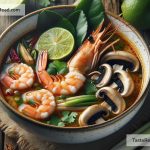How the Thai Som Tum Conquered the Streets
When it comes to street food, few dishes can match the tangy, spicy, and utterly refreshing taste of Thai Som Tum. This vibrant salad, which originates from the northeastern part of Thailand, is a harmonious blend of shredded green papaya, tomatoes, carrots, peanuts, dried shrimp, lime juice, fish sauce, sugar, and chili. Its unique flavor profile — a mix of sour, sweet, salty, and spicy — has captivated the taste buds of people around the globe, making Som Tum a standout dish in the world of street foods.
But how did this humble salad become a global phenomenon? Let’s take a culinary journey to discover the evolution of Som Tum and its rise to fame.
Roots in the Rice Fields
Som Tum’s story begins in the rustic landscapes of Northeast Thailand, also known as Isan. Here, farmers would often prepare Som Tum in the fields, using ingredients readily available to them. The primary ingredient, unripe green papaya, was a clever choice — it’s not only abundant but also resilient, able to withstand the tropical heat without spoiling.
Initially, Som Tum was a simple mixture of pounded green papaya, fish sauce, lime, chili, and maybe a bit of palm sugar for balance. Over time, locals started adding more ingredients like tomatoes, peanuts, and dried shrimp, making it the hearty dish we know and love today.
Journey to the City
Som Tum began its migration from the rural areas of Isan to the bustling streets of Bangkok in the latter half of the 20th century. As people moved to the city for work, they brought their culinary traditions with them, setting up small food stalls and carts to earn a living. Among the dishes they offered was Som Tum, which quickly gained popularity among Bangkok’s residents for its bold flavors and refreshing qualities.
What made Som Tum stand out in the crowded streets of Bangkok was its versatility. It could serve as a light, standalone meal, or accompany heavier dishes like grilled chicken or sticky rice, making it suitable for any time of the day. Additionally, its preparation was a spectacle in itself. Vendors would skillfully pound the ingredients in a mortar, drawing crowds with the rhythmic sounds and the enticing aroma.
Global Sensation
As Thailand became a hotspot for tourism, visitors from across the globe were introduced to the joys of Som Tum. Captivated by its novel taste and the flair of its preparation, tourists took stories of this remarkable dish back home, spreading its fame far and wide.
Nowadays, Som Tum is not just a street food staple in Thailand but a treasured dish in many countries, available in everything from high-end restaurants to local street markets. What’s more, its recipe has welcomed modifications and variations, adapting to different palates while maintaining its core identity.
The Secret to Its Success
Several factors contribute to the popularity of Som Tum. First and foremost is its taste. The combination of sour, sweet, salty, and spicy appeals to a broad audience, capturing the essence of Thai cuisine in a single dish. Moreover, its health benefits cannot be overlooked. Made primarily with raw vegetables, Som Tum is low in calories but high in vitamins and fiber, aligning well with the modern desire for healthier eating options.
Another key factor is the dining experience. Eating Som Tum is more than just consuming a meal; it’s a communal activity that brings people together. In Thailand, it’s common to see families and friends gather around a table laden with a large mortar of Som Tum, taking turns to sample the salad and share their food.
Conclusion
The journey of Som Tum, from the rural fields of Isan to the bustling streets of Bangkok and beyond, is a testament to the power of simplicity and tradition. It encapsulates the spirit of Thai cuisine — an adventurous blend of flavors, a dedication to fresh ingredients, and a culture that celebrates sharing and togetherness.
Whether served at a street corner, in a local eatery, or a fine dining restaurant, Som Tum remains a beloved dish, cherished by many. Its enduring popularity is not just a trend but a reflection of the timeless appeal of Thai cuisine and its ability to connect people from different walks of life through the universal language of food.


